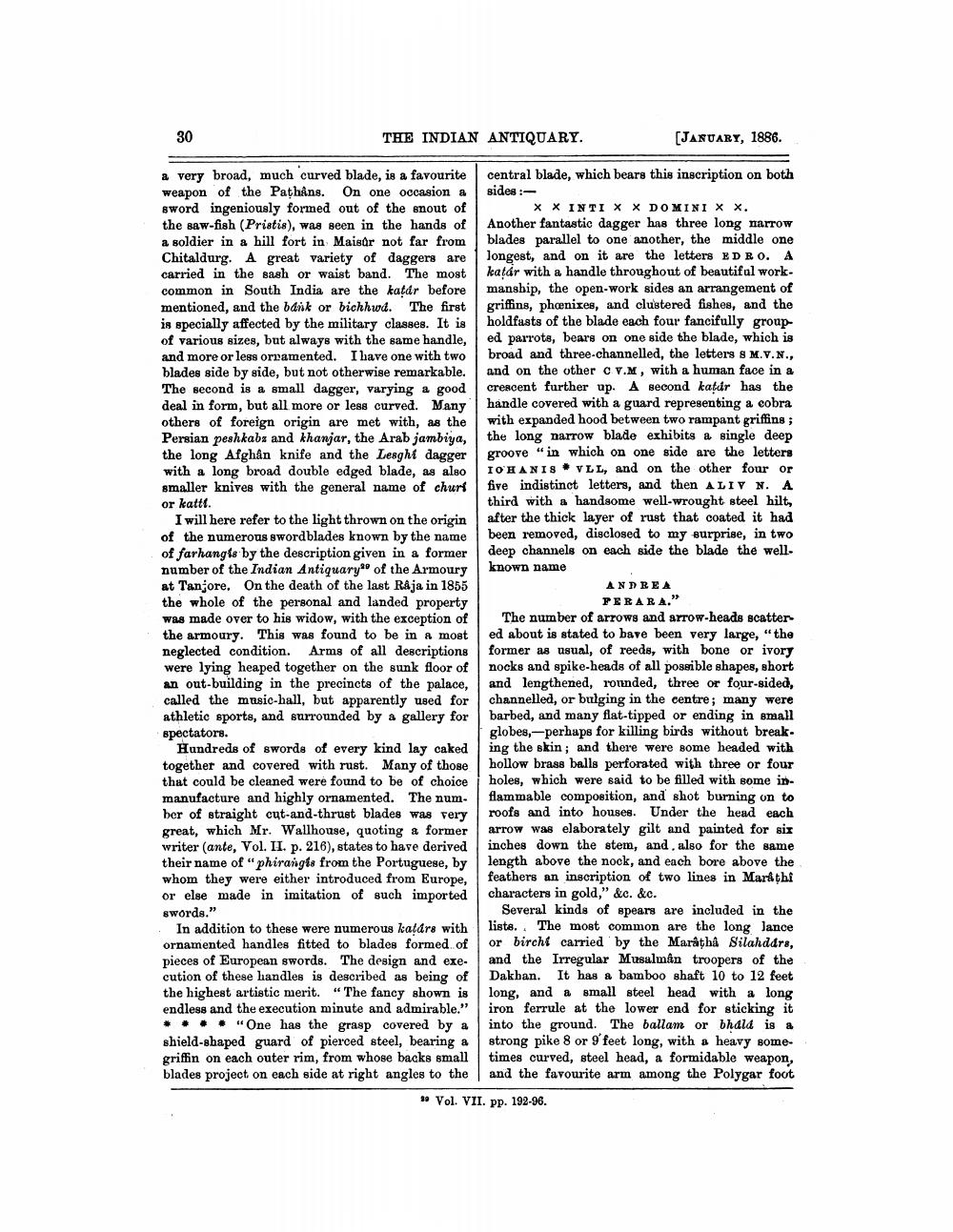________________
30
THE INDIAN ANTIQUARY.
(JANUARY, 1886.
a very broad, much curved blade, is a favourite central blade, which bears this inscription on both weapon of the Pathậns. On one occasion a sides :sword ingeniously formed out of the snout of
X X INTI X X DOMINI X X. the saw-fish (Pristis), was seen in the hands of Another fantastic dagger has three long narrow a soldier in a hill fort in Maisar not far from blades parallel to one another, the middle one Chitaldurg. A great variety of daggers are longest, and on it are the letters EDRO. A carried in the sash or waist band. The most katár with a handle throughout of beautiful work. common in South India are the katar before manship, the open-work sides an arrangement of mentioned, and the bank or bichhwd. The first griffins, phenixes, and clustered fishes, and the is specially affected by the military classes. It is holdfasts of the blade each four fancifully groupof various sizes, but always with the same handle, ed parrots, bears on one side the blade, which is and more or less ornamented. I have one with two broad and three-channelled, the letters & M.V.N., blades side by side, but not otherwise remarkable. and on the other c v.m, with a human face in a The second is a small dagger, varying a good crescent further up. A second katur has the deal in form, but all more or less curved. Many handle covered with a guard representing a cobra others of foreign origin are met with, as the with expanded hood between two rampant griffins ; Persian peshkabz and khanjar, the Arab jambiya, the long narrow blade exhibits a single deep the long Afghân knife and the Lesght dagger groove "in which on one side are the letters with a long broad double edged blade, as also IOHANIS • VLL, and on the other four or smaller knives with the general name of churt five indistinct letters, and then ALIV N. A or katti
third with a handsome well-wrought steel hilt, I will here refer to the light thrown on the origin after the thick layer of rust that coated it had of the numerous swordblades known by the name been removed, disclosed to my surprise, in two of farhangts by the description given in a former deep channels on each side the blade the wellnumber of the Indian Antiquary of the Armoury known name at Tanjore. On the death of the last Raja in 1855
ANDREA the whole of the personal and landed property
PERAR A." was made over to his widow, with the exception of The number of arrows and arrow-heads scatter the armoury. This was found to be in a most ed about is stated to bave been very large, "the neglected condition. Arms of all descriptions former as usual, of reeds, with bone or ivory were lying heaped together on the sunk floor of nocks and spike-heads of all possible shapes, short an out-building in the precincts of the palace, and lengthened, rounded, three or four-sided, called the music-ball, but apparently used for channelled, or bulging in the centre; many were athletic sports, and surrounded by a gallery for barbed, and many flat-tipped or ending in small
globes,-- perhaps for killing birds without breakHandreds of swords of every kind lay caked ing the skin; and there were some headed with together and covered with rust. Many of those hollow brass balls perforated with three or four that could be cleaned were found to be of choice holes, which were said to be filled with some inmanufacture and highly ornamented. The num- flammable composition, and shot burning on to ber of straight cut-and-thrust blades was very roofs and into houses. Under the head each great, which Mr. Wallhouse, quoting a former arrow was elaborately gilt and painted for six writer (ante, Vol. II. p. 216), states to have derived inches down the stem, and also for the same their name of "phirangis from the Portuguese, by length above the nock, and each bore above the whom they were either introduced from Europe, feathers an inscription of two lines in Marathi or else made in imitation of such imported characters in gold," &c. &c. swords."
Several kinds of spears are included in the In addition to these were numerous kalare with lists. The most common are the long Jance ornamented handles fitted to blades formed of or birche carried by the Maratha Silahddrs, pieces of European swords. The design and exe. and the Irregular Musalman troopers of the cution of these handles is described as being of Dakhan. It has a bamboo shaft 10 to 12 feet the highest artistic merit. “The fancy shown is long, and a small steel head with a long endless and the execution minute and admirable." iron ferrule at the lower end for sticking it .... "One has the grasp covered by a into the ground. The ballam or bhala is a shield-shaped guard of pierced steel, bearing a strong pike 8 or 9' feet long, with a heavy somegriffin on each outer rim, from whose backs small times curved, steel head, a formidable weapon, blades project on each side at right angles to the and the favourite arm among the Polygar foot
** Vol. VII. pp. 192-96.
spectators.




